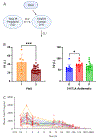A Pharmacokinetic/Toxicodynamic Model of Cisplatin Nephrotoxicity Using the Kidney Injury Molecule-1 Biomarker
- PMID: 39726772
- PMCID: PMC11671133
- DOI: 10.47739/pharmacology1184
A Pharmacokinetic/Toxicodynamic Model of Cisplatin Nephrotoxicity Using the Kidney Injury Molecule-1 Biomarker
Abstract
Cisplatin is a platinum-based chemotherapeutic that causes acute kidney injury in over 30% of patients. The aim of this study was to develop a population pharmacokinetic/toxicodynamic (PKTD) model of cisplatin-induced kidney injury that incorporated plasma total platinum and urinary kidney injury molecule-1 (KIM-1) concentrations. Cancer patients receiving their first or second round of cisplatin-containing chemotherapy (n=39) were prospectively randomized to a 5-HT3 antagonist (5-HT3A) antiemetic (ondansetron, granisetron, or palonosetron) and had blood and urine collected over 10 days. Plasma concentrations of total platinum and urinary concentrations of KIM-1 were used in the development of a nonlinear mixed effect population PKTD model using Phoenix® NLME (v8.3, Certara Inc.). A stepwise search was used to test potential covariates that influenced PKTD parameters. A two-compartment model best described the plasma total platinum concentration vs. time data and was expanded to an effect compartment PKTD model incorporating urinary KIM-1 concentrations. Significant covariate effects for the PKTD model included previous cisplatin exposure on the volume of the central compartment (V1), 5-HT3A antiemetic treatment on the volume of the peripheral compartment (V2), and baseline urinary KIM-1 levels on the maximum effect (Emax) parameter. The model demonstrated that ondansetron-treated subjects had a 163% increase in exposure to plasma total platinum, a 94% increase in urinary KIM-1 maximum concentrations, and a 235% increase in total urinary KIM-1 excretion compared to palonosetron-treated subjects, suggesting that palonosetron may be a preferred 5-HT3A to reduce the risk of cisplatin-induced kidney injury.
Keywords: 5-HT3 Antagonist; Cisplatin; Kidney Injury; Nephrotoxicity; Pharmacodynamics; Pharmacokinetics; Toxicodynamics.
Conflict of interest statement
CONFLICT OF INTEREST The authors declare no conflicts of interest. Lauren M. Aleksunes is a member of the scientific advisory board of RenaSym® Simulations Plus.
Figures








Similar articles
-
Population Pharmacokinetic Model of Platinum Disposition in Cancer Patients Receiving Cisplatin and Randomized to 5-HT3 Antagonist Antiemetic Drugs.J Clin Pharmacol. 2025 Jun;65(6):763-778. doi: 10.1002/jcph.6177. Epub 2024 Dec 22. J Clin Pharmacol. 2025. PMID: 39711135 Free PMC article. Clinical Trial.
-
Pharmacokinetic determinants of cisplatin-induced subclinical kidney injury in oncology patients.Eur J Clin Pharmacol. 2019 Jan;75(1):51-57. doi: 10.1007/s00228-018-2552-z. Epub 2018 Sep 15. Eur J Clin Pharmacol. 2019. PMID: 30220072 Free PMC article.
-
Urine Neutrophil Gelatinase-Associated Lipocalin and Kidney Injury Molecule-1 to Detect Pediatric Cisplatin-Associated Acute Kidney Injury.Kidney360. 2021 Nov 3;3(1):37-50. doi: 10.34067/KID.0004802021. eCollection 2022 Jan 27. Kidney360. 2021. PMID: 35368557 Free PMC article.
-
Time-dependent changes in kidney injury biomarkers in patients receiving multiple cycles of cisplatin chemotherapy.Toxicol Rep. 2020 Apr 22;7:571-576. doi: 10.1016/j.toxrep.2020.04.003. eCollection 2020. Toxicol Rep. 2020. PMID: 32382514 Free PMC article. Review.
-
The Predictive Role of the Biomarker Kidney Molecule-1 (KIM-1) in Acute Kidney Injury (AKI) Cisplatin-Induced Nephrotoxicity.Int J Mol Sci. 2019 Oct 22;20(20):5238. doi: 10.3390/ijms20205238. Int J Mol Sci. 2019. PMID: 31652595 Free PMC article. Review.
Cited by
-
Single cell ICP-MS for the assessment of potential nephroprotectors against cisplatin.Mikrochim Acta. 2025 Jul 23;192(8):514. doi: 10.1007/s00604-025-07383-8. Mikrochim Acta. 2025. PMID: 40699350 Free PMC article.
References
Grants and funding
LinkOut - more resources
Full Text Sources
